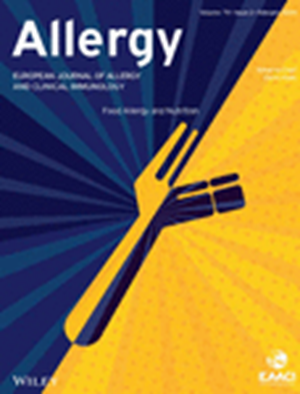永久化学品:基于人群的全氟和多氟烷基物质暴露及其对鼻腔健康影响的探索性分析
IF 12
1区 医学
Q1 ALLERGY
引用次数: 0
摘要
全氟和多氟烷基物质(PFAS)是广泛使用的化学品,特别是在不粘涂料、消防泡沫和设备以及表面活性剂中。这些化学物质降解缓慢,并在组织和环境中积累,在世界各地的水、空气、野生动物和土壤中都能检测到。初步研究表明,这些化学物质与有害的健康影响有关,但在这一领域的研究仍然有限,特别是在鼻腔疾病方面。方法采用2011-2014年美国国家健康与营养调查(NHANES)的完整数据(n = 1911),分析PFAS与味觉和嗅觉调查的相关性。调查包括自我报告的鼻窦症状。采用校正协变量的多变量logistic回归来描述血清PFAS浓度与鼻腔健康之间的关系。使用贝叶斯核机回归(BKMR)来考虑PFAS的不同化学性质以及现实生活中暴露如何涉及多种类型的PFAS。结果logistic回归模型发现,除了血清Me - PFOSA - AcOH (OR: 1.164; 95% CI: 1.020-1.308)显著增加了过去12个月报告频繁鼻塞的可能性外,血清PFAS水平与鼻窦健康结局无显著相关性。BKMR模型发现,随着混合物中PFNA浓度的增加,Me - FPOSA - AcOH和PFHxS的嗅觉暴露-反应关系变得更加明显。结论本研究结果探讨了PFAS与鼻窦健康不良之间的潜在关系。暴露于Me - PFOSA - AcOH可能与频繁的鼻塞有关,而其他PFAS可能对嗅觉有复杂的混合物依赖作用。本文章由计算机程序翻译,如有差异,请以英文原文为准。
Forever Chemicals: An Exploratory, Population‐Based Analysis of Per‐ and Polyfluoroalkyl Substances Exposure and Effects on Sinonasal Health
IntroductionPer‐ and Polyfluoroalkyl Substances (PFAS) are widely used chemicals, notably in nonstick coatings, fire‐fighting foams and equipment, and surfactants. These chemicals degrade slowly and accumulate in tissues and the environment, being detected in water, air, wildlife, and soil across the world. Initial studies have shown that these chemicals are associated with harmful health effects, but research in this area remains limited, especially in sinonasal diseases.MethodsThe National Health and Nutrition Examination Survey (NHANES) 2011–2014 was used to analyze the association between PFAS and taste and smell survey among adults (age ≥ 40) with complete data (n = 1911). The survey included self‐reported sinonasal symptoms. Multivariable logistic regression adjusted for covariates was used to describe the relationship between serum PFAS concentrations and sinonasal health. Bayesian kernel machine regression (BKMR) was performed to consider the diverse chemical properties of PFAS and how real‐life exposures involve multiple types of PFAS.ResultsThe logistic regression model found that serum PFAS levels were not significantly associated with sinonasal health outcomes, except serum Me‐PFOSA‐AcOH (OR: 1.164; 95% CI: 1.020–1.308), which significantly increased the likelihood of reporting frequent nasal congestion in the past 12 months. The BKMR model identified exposure–response relationships on olfaction of Me‐FPOSA‐AcOH and PFHxS becoming more pronounced as the concentration of PFNA within the mixture increased.ConclusionOur results explore potential relationships between PFAS and adverse sinonasal health effects. Exposure to Me‐PFOSA‐AcOH may be related to frequent nasal congestion, while other PFAS may have complex, mixture‐dependent effects on olfaction.
求助全文
通过发布文献求助,成功后即可免费获取论文全文。
去求助
来源期刊

Allergy
医学-过敏
CiteScore
26.10
自引率
9.70%
发文量
393
审稿时长
2 months
期刊介绍:
Allergy is an international and multidisciplinary journal that aims to advance, impact, and communicate all aspects of the discipline of Allergy/Immunology. It publishes original articles, reviews, position papers, guidelines, editorials, news and commentaries, letters to the editors, and correspondences. The journal accepts articles based on their scientific merit and quality.
Allergy seeks to maintain contact between basic and clinical Allergy/Immunology and encourages contributions from contributors and readers from all countries. In addition to its publication, Allergy also provides abstracting and indexing information. Some of the databases that include Allergy abstracts are Abstracts on Hygiene & Communicable Disease, Academic Search Alumni Edition, AgBiotech News & Information, AGRICOLA Database, Biological Abstracts, PubMed Dietary Supplement Subset, and Global Health, among others.
 求助内容:
求助内容: 应助结果提醒方式:
应助结果提醒方式:


